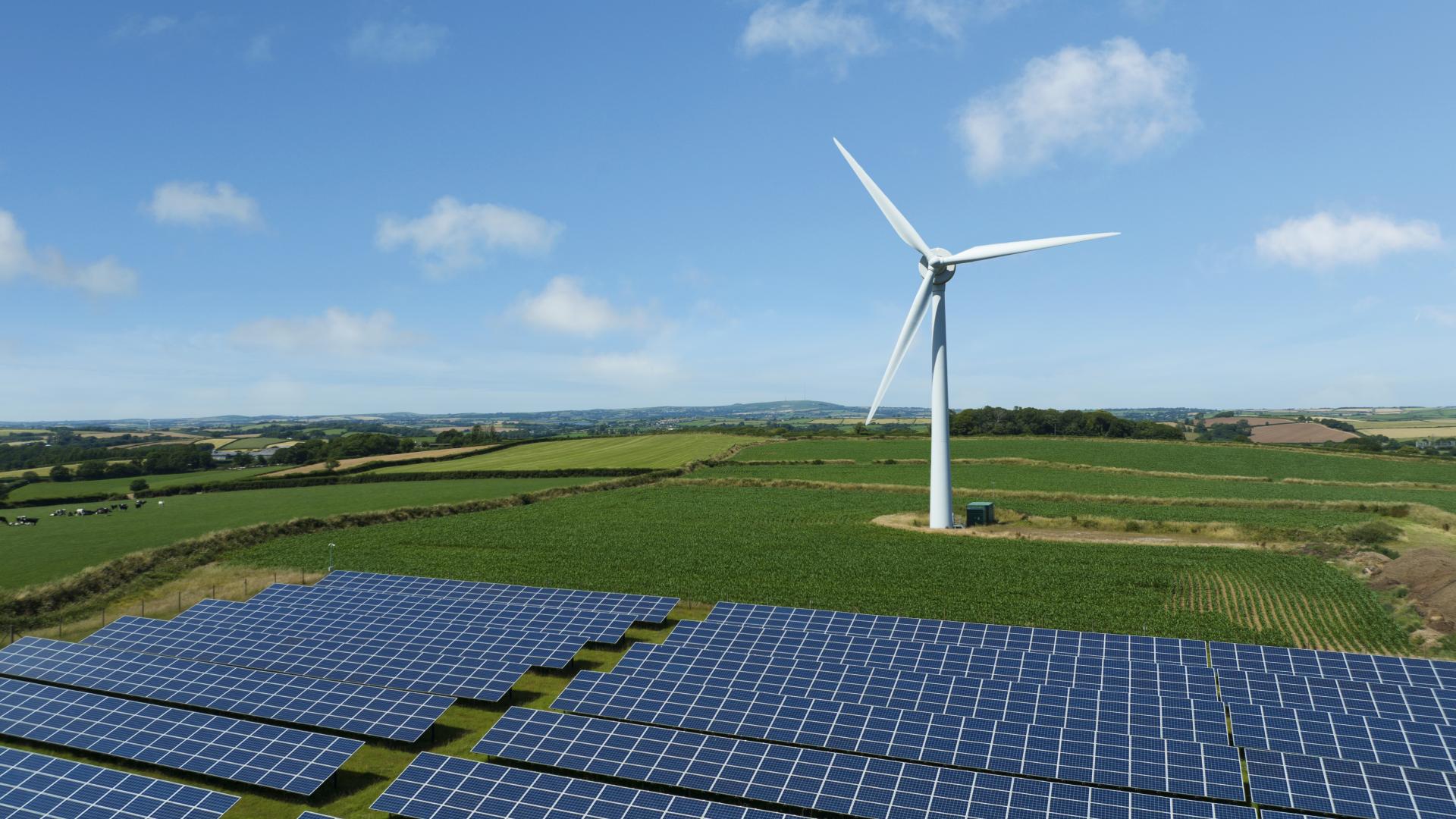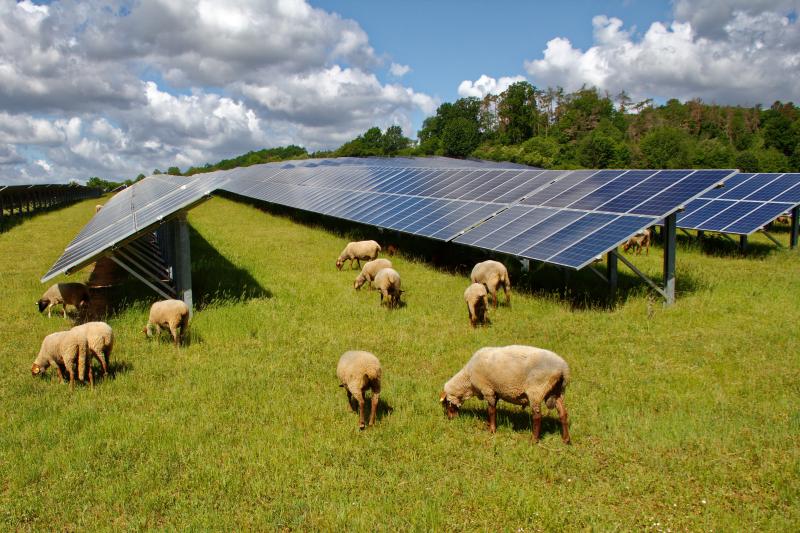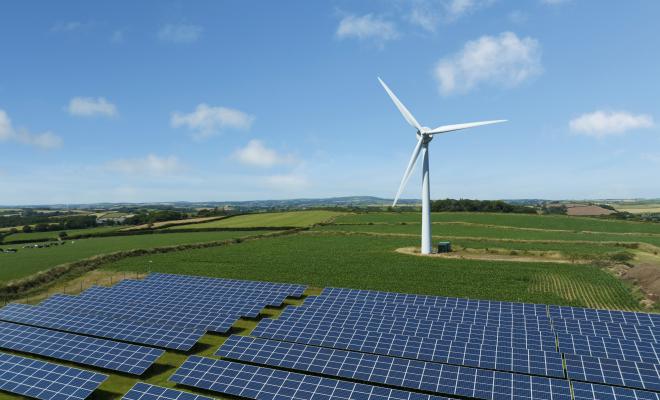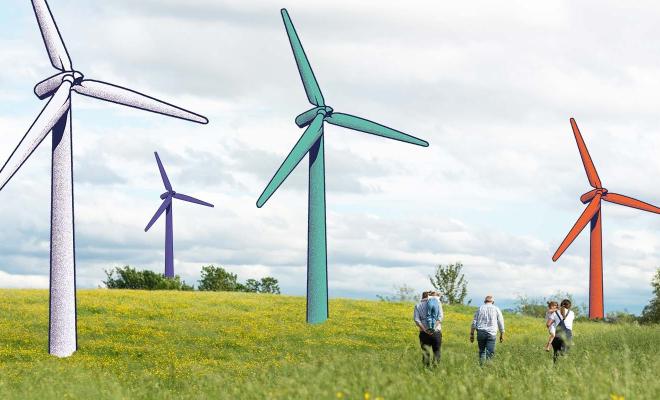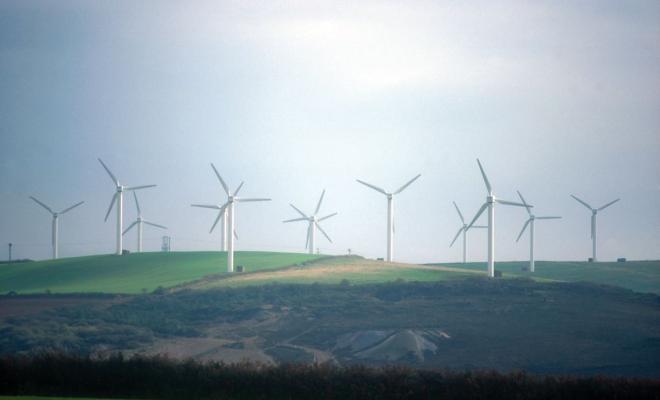24 Apr 2025
***This article was first published in April 2024 and has since been updated with new figures following feedback on our previous analysis, particularly on the size of buffer zones around heritage sites. Working with WeWantWind.org, we’ve analysed how existing and planned renewable sites match up to areas we’ve identified as most suitable for development. There have also been significant policy changes over the past year, and this article has been updated in light of these.***
Wind and solar farms are by far the cheapest forms of electricity production. For example, electricity from gas-fired power stations is almost 3 times more expensive to produce. More renewable electricity production can therefore help lower energy bills. It will also reduce carbon emissions as it displaces gas-fired electricity and as transport and heating are electrified. Electrifying heating and transport are essential for meeting the UK’s international commitment to cut carbon emissions by 68% by 2030.
The UK therefore needs a lot more renewable electricity. The National Energy System Operator (NESO) has suggested electricity demand will be 11% higher than it currently is by 2030 and will double by 2050. It suggests the quantity of onshore wind will need to double and solar power treble to meet 2030 electricity decarbonisation targets.
This means almost 10 GW of new onshore renewable capacity should be developed each year (average new capacity over the past 10 years has been less than 4 GW1). To contextualise this, one of the biggest existing onshore wind farms is the Clyde Wind Farm in Scotland, which has 206 turbines with an installed capacity of 0.5 GW.
How did we identify suitable locations for renewable energy?
Offshore wind farms will be the backbone of Britain’s future electricity production. But they take time to build. 10+ years is typical, although that could be reduced to 5-6 years according to the government’s Offshore Wind Champion. The government is seeking to grow offshore wind rapidly, including through a record-breaking auction in autumn 2024.
But if the UK is to produce the cheap, green electricity it needs by 2030, we need to see lots more onshore renewable energy as well, and quickly. For reasons of speed, most of this will need to be built near to where the electricity grid already has spare capacity.
Onshore renewable energy is fast to build, taking as little as 1 year if planning and grid constraints are resolved. The government has amended planning policy to remove long-standing, unfair constraints on onshore wind introduced by the previous Conservative government. It’s shifted the balance in favour of granting permission for onshore renewable energy developments in the National Planning Policy Framework (NPPF).
Developments are also held up by long delays in hooking up to an antiquated electricity grid that’s not fit for purpose. Reforms to speed up connections to the grid are underway and new grid lines being developed. Friends of the Earth is supportive of these changes.
For our original analysis published in 2024, Friends of the Earth worked with the UKRI Centre for Doctoral Training in Environmental Intelligence based at the University of Exeter to identify the land that could be most suitable for new onshore renewable energy. For this updated analysis, we’ve taken on board feedback we’ve received from developers and others since we first published the article.
For both iterations, we identified the land that's less suitable for onshore wind or solar farms, although developments may still be possible in these areas with care (eg fewer turbines). See our methodology for more detailed information on land we’ve excluded.
We’ve been deliberately conservative in this analysis, for example we excluded:
- Solar farms on higher grade agriculture land. In practice, some land that’s designated as “excellent” or “very good” may be degraded and is therefore suitable for development. While food security is important, losing 1% of this land to solar wouldn’t make a significant difference. In addition, existing grid capacity for new renewables is often in areas of higher-grade agricultural land. If we’re to build enough renewable energy quickly enough, we’re going to have to use some of this land. Friends of the Earth will continue to support solar farms on higher grade agricultural land on a case-by-case basis (especially due to the temporary nature of such developments compared with say a house with a 100+ year lifespan), even though our preference is for these solar developments to be predominately on poorer quality agricultural land, in addition to utilising the potential for rooftop solar, solar car parks etc.
- Wind and solar farms in National Parks and Areas of Outstanding Natural Beauty (AONBs). We’d support smaller developments in these areas if sensitively located. We also support the National Farmers’ Union and RenewableUK’s call for small turbines (ie less than 25 metres tall) to be granted planning permission (so-called “permitted development”) in such protected landscapes, subject to prior approval.
- Wind and solar farms close to sites of heritage. For both wind and solar we’ve added buffers around all Grades I and II* buildings (500 metres for solar, 750 metres for wind), registered parks and gardens (300 metres for solar, 1 km for wind), and scheduled monuments (300 metres for solar, 500 metres for wind). In many cases smaller buffers may be appropriate.
- Small developments. We’ve excluded areas of land smaller than 1 hectare (2.5 acres) for solar farm developments and 5 hectares (12 acres) for wind farms. Smaller solar projects, single wind turbines or several small wind turbines may practically use areas smaller than this, but the electricity they produce will be more expensive.
- Rooftop solar. This analysis excluded an assessment of rooftop solar and the co-location of solar with car parks etc. It also excludes the future potential for agrivoltaics (co-locating solar and agricultural production). This was for practical reasons, but we recognise that these do have important contributions to make.
- Wind in areas of low wind speed. Some areas will be uneconomical for developing new wind farms because the wind speed is too low. Sites with wind speeds of less than 5 metres per second at 50 metres above ground have been excluded. The industry is likely to favour areas with the highest wind speeds.
For our calculations of energy generation potential, we also prioritised wind farms over solar farms where the land is suitable for both, so solar estimates are lower than they otherwise would be. We did this because, as we switch to electric heating, much of our electricity demand in the future will be in winter, and wind farms are more productive than solar, especially in winter. Increasingly however, wind and solar can be co-located on the same site, alongside energy storage, with careful design. It should also be noted that the land around wind and solar can be used for other purposes as well, for example farming around turbines and biodiversity gain or sheep grazing around solar panels.
On the other hand, there will be some areas we’ve identified as most suitable that may in practice not be suitable. For example, we haven’t been able to map unsuitable areas due to radar interference for aircraft or migratory routes for birds. In addition, important nature sites aren’t always well identified or officially designated in the UK, ie while European and nationally designated wildlife sites were automatically excluded, not all sites at the local and country level have statutory protection.
Any solar or onshore wind projects will need to investigate these issues before development can be granted. Experience shows that developments done well can enhance biodiversity, but without proper on-the-ground assessment by trained ecologists they can also be harmful. And not all the sites we’ve identified will be economically viable in practice, for example due to the costs of connecting to the grid.
We also haven’t considered the cumulative impact of development in a particular area. This is an important issue and requires further consideration. The Landscape Institute’s 2013 guidance may be a good starting point.
Where can England build new renewable energy?
Even with this conservative approach, we’ve identified 7,992 km2 of land most suitable in England for onshore wind (6.1% of all land) and 18,563 km2 for solar farms (14.2% of all land). Because some of this land is the same, this is equal to 16% of land overall and has the theoretical potential to equal 347,416 GWh of onshore wind energy and 570,690 GWh of solar energy per year. The total 918,106 GWh of electricity is far in excess of what’s needed.
If this capacity was fully developed, which isn't necessary, and if wind was prioritised above solar on sites that are suitable for both, this land would produce 50 times the current onshore wind and solar electricity generation across England. This figure is more than 3 times greater than our previous estimate, largely as a result of reducing the size of buffers around the thousands of listed buildings.
This is equivalent to more than 10 times the electricity currently consumed by homes. This shows that, alongside estimates for huge offshore wind potential,2 offshore solar and rooftop solar, the UK not only easily has the potential to meet its own energy needs, but it could also become a green energy superpower exporting clean, cheap, green electricity to other countries.
Our full data analysis and interactive map present our data analysis by local authority areas. The areas we’ve identified as most suitable are also available to view in this interactive map. And we’ve developed separate maps that show which areas have been excluded and why (onshore wind exclusion map and solar farm exclusion map). We’ve also developed a campaign guide to help community groups support applications for wind and solar developments.
Map – data analysis by local authority and the most suitable areas for development
Table 1 shows the 10 local authority areas with the greatest total potential for renewable energy generation within 5 km proximity of an electricity grid substation. Table 2 shows 10 local authority areas with the greatest total potential for renewable energy generation without considering the proximity of the grid. Economics and speed are likely to favour development near the grid, but larger developments may still be economical at greater distances. In addition, some new grid lines are likely to be developed in future years.
There are several other estimates in the literature for the potential land available for onshore wind and solar farms, as reviewed by O’Callaghan et al from Oxford University in a recent study. The quantities differ significantly depending on the technical constraints and assumptions made (for example, regarding political and/ or social appetite).
Our analysis is only for England rather than all of Great Britain and so it’s not directly comparable, but our figures are in the same ballpark. The Oxford University study cites earlier research which estimates 18%-44% of land would be suitable for onshore wind. Our figure is only 6.1% but this excludes Scotland and Wales. For solar, our conservative estimate is 14.2% of land. The Oxford University study cites earlier work with estimates ranging from 0.2% to 11% of land.
Which policies can release England’s potential for renewables?
Since the general election last year, there’s been substantial and welcome progress in developing and amending policy to rapidly grow onshore renewable energy in England. For example:
- The de-facto planning policy ban on onshore wind has been removed.
- “Significant weight” has been apportioned to renewable energy developments within the NPPF (in terms of their benefits and how they’ll help the UK reach net zero).
- The UK government has asked NESO to develop a map of pre-assessed areas for wind and solar. Our mapping will hopefully help with this, and we’re feeding into its development process.
- The need for “compelling evidence” for solar farm proposals has been relaxed/ removed.
- Developing a grid for the 21st century has been made a top infrastructure priority.
- Residents around grid developments will be offered £250 a year off their energy bills for 10 years. A similar scheme is needed for solar and wind. Solar Energy UK is developing a best practice guide for community engagement, which we hope the wind industry will also follow.
- Both onshore wind and solar projects over 100 MW are now considered within the Nationally Significant Infrastructure Projects (NSIPs) regime, meaning wind and solar are now treated in the same way and only the biggest projects need to go through the more time-consuming NSIPs process.
But there are some outstanding policy/ legislative changes still needed:
- The statutory pre-application requirement for more than 2 turbines/ any turbines with a hub height of over 15 metres should be scrapped, with best practice community engagement principles used instead.
- All renewable developments should be required to deliver biodiversity net gain benefits significantly greater than the 10% statutory minimum for Town and Country Planning Act applications. Solar Energy UK has published best practice guidelines which should be followed.
Methodology
There are different constraints to solar and onshore wind, so these are looked at separately. To identify constraints we drew on advice provided to Stroud Council by LUC and the Centre for Sustainable Energy and advice from our in-house planning expert.
After constraints were considered, we multiplied the potential land area for wind by 19.8 MW per km2 based on a 2021 study and for solar by 50 MW per km2 based on current practice. We then multiplied both by capacity factors (estimates of the proportion of time the technology will be producing energy over the course of a year) to arrive at an approximation of potential energy production. As stated earlier, where land has the potential for wind and solar we’ve prioritised wind. In practice, a choice might be made to use this land for solar instead or to co-locate wind and solar.
- 1
Using the National Grid Future Energy Scenarios identified above, and also the Climate Change Committee’s figures in its 2023 Progress Report.
- 2
A recent study by Oxford University suggested offshore wind could eventually produce over 2,000 TWh of electricity against a projected total need of 1,500 TWh.


